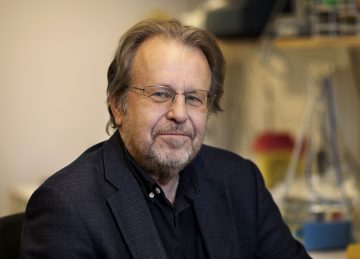AUTUMN TERM. By early fall, our teaching premises are expected to be usable at 50 percent of capacity. Piecing the timetable together to fit in all the priority students is an intricate job. For staff, the return will take place in stages, according to the needs of their various activities. Barring unforeseen delays, campus life will be more back to usual from November 1st.

“Although the distance teaching worked well under the circumstances, and also sometimes gave added value, lots of us surely look forward to being together on campus again. Student–teacher dialogue is immensely important for learning. And after all, it’s bound to be more animated without the ‘digital filter’,” says Gunnar Tobin, Sahlgrenska Academy’s Vice-Dean for Education.
“The way the rules are for now,” he continues, “we can’t go back to fully normal occupancy at once. We all need to grasp this, and that’s why we have to help one another out in the transition stage, to make it as frictionless as possible. It will be great to meet up again!”
Half-full premises
On June 10th, Dean Agneta Holmäng took a new decision on education in response to the Vice-Chancellor’s revised specialization decision for the fall semester 2021. The Dean’s decision means that educational premises can be reserved at 50 percent of their capacity, to prevent crowding and guarantee that students can keep their distance from one another. The recommendation is for the seats to be one meter apart. Using the Clinical Training Center (CTC) at up to half its capacity will also be possible.
Many priority groups
The decision also specifies which student categories and teaching activities are to be prioritized on campus during the first few months of the fall semester. Freshmen will be allowed to attend introductory events and arrangements on campus, and the students starting the last semester of their study programs will also have priority. Students who have joined courses in the past year, and therefore studied only at a distance to date, will also get the opportunity for face-to-face teaching; so, too, will the international students arriving in Gothenburg. Examinations that cannot be implemented in any other way than through physical attendance, and special teaching elements such as lab and other work, will also be given space in the premises.
Recommendations for all teaching

“Many of our student groups will have priority, so it’s hard to make the premises adequately meet needs. Since our premises’ capacity is halved, course coordinators will also need, in many cases, to prioritize between the parts of the education that must be given on site and the teaching that can be done digitally. Although the teaching premises available in Sahlgrenska University Hospital’s facilities aren’t covered by our rules, we still want to recommend teachers to adhere to the intentions of our Dean’s decision there too, and ensure that students can keep their distance from one another,” says Annelie Hyllner, Head of the Education Department at Sahlgrenska Academy’s faculty office.
Workplace training, on and off campus, should also be possible to implement in physical form.
Larger groups in the Wallenberg Hall
To allow large-scale courses to be held, especially in the Medical and Nursing Programs, the Faculty will hire the Wallenberg Hall in the Wallenberg Conference Center. From August 30th, the examination halls in Viktoriagatan will open, and a decision from the Head of Department will no longer be a requirement for booking a hall for an exam. However, the capacity will be somewhat reduced in comparison with the normal seating arrangements.
Information from line manager and course managers
For employees, the return to campus will take place gradually. It will vary from one staff group to another, depending on their work duties. Anyone who has special needs can discuss them with their line manager, who is the person who will provide information about, and decide how, the return is to take place within the activity concerned. As for the students, it is the course managers’ responsibility to ensure that details of how the teaching will take place reach the students.
The long period of working from home will continue to affect our work life in the future, but how exactly is not yet clear. At University level, a working group with support from Human Resources has investigated the requirements for a flexible work life within the University, in which working from home can be combined with work on campus. This report has been presented to the Vice-Chancellor.
The Dean’s decision (in Swedish)
BY: ELIN LINDSTRÖM











